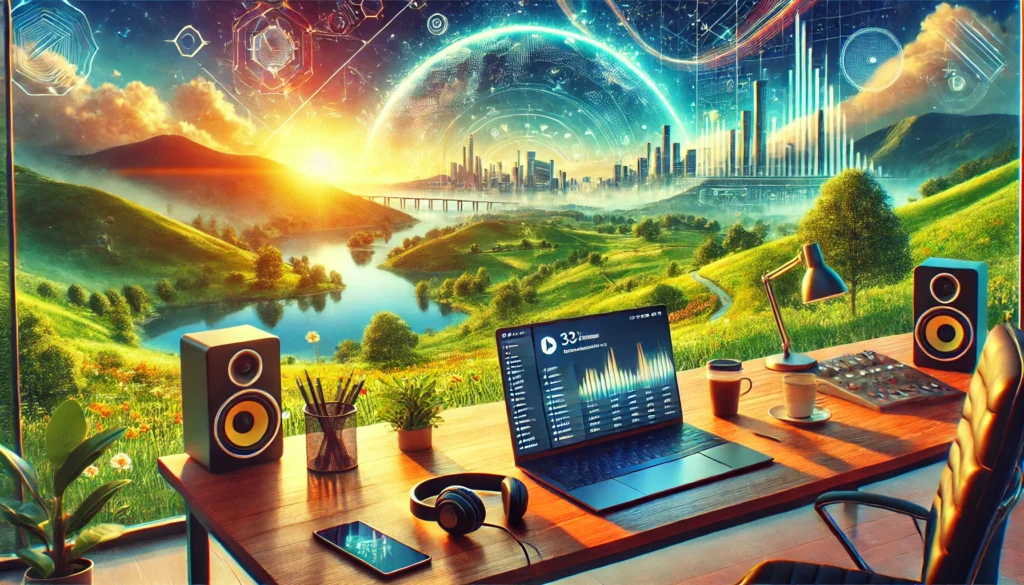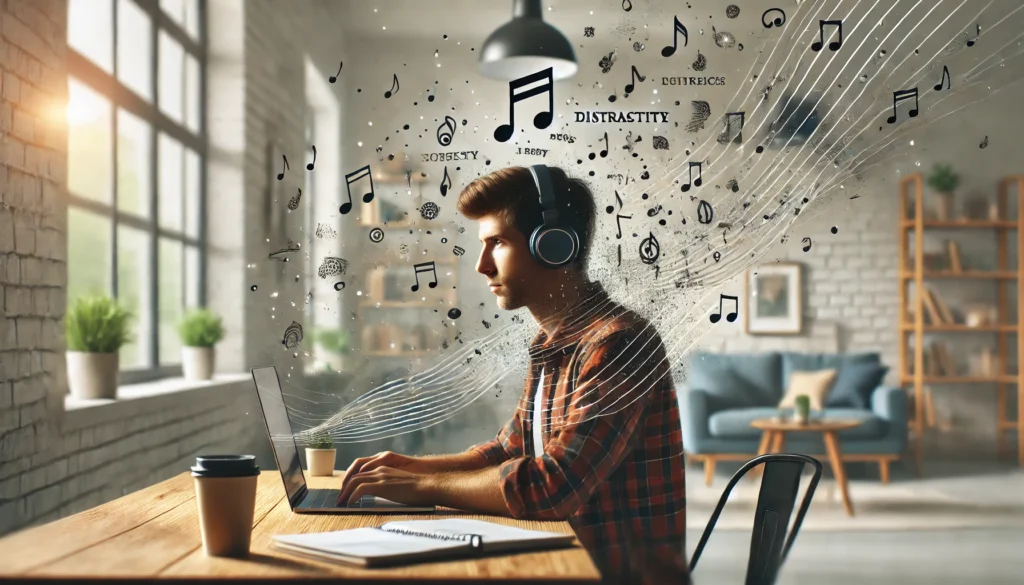Key Takeaways
- The right music can increase productivity by up to 15% when matched to appropriate work tasks
- Instrumental genres generally outperform lyrical music for concentration-intensive activities
- Classical music is by far on of the best music genres for focus and boosting concentration
- Different music genres activate distinct neural pathways, making some better suited for specific types of work
- Personalized playlists based on task type yield better results than random background music
- Regular musical breaks can prevent mental fatigue and maintain optimal focus throughout the workday
Best Music Genres for Focus
Have you ever noticed how the right song can transform your workday? It’s not just your imagination. Music genuinely enhances our ability to focus and produce quality work. Research published in the Journal of Applied Research in Memory and Cognition confirms what many of us intuitively feel: background music can significantly boost productivity—but only when carefully selected.
The science is clear: our brains respond differently to various musical structures. Some genres create an auditory landscape that promotes deep work, while others might pull our attention away from important tasks. Finding your perfect work soundtrack isn’t just about personal preference; it’s about understanding how different types of music interact with your cognitive processes.
Whether you’re writing code, designing presentations, or analyzing spreadsheets, the right audio backdrop can mean the difference between distraction and flow state. Let’s explore the top ten music genres proven to enhance workplace focus and discover which one might be your perfect productivity partner. Lets take a look at the best music genres for focus and productivity.
ALSO: The Science Behind Music and Concentration
ALSO: The Ultimate Music and Productivity Guide
1. Classical Music
Why it works
Classical music is by far on of the best music genres for focus and boosting concentration. The structured compositions and harmonious patterns in classical music stimulate neural pathways associated with spatial reasoning. This activation creates an ideal environment for complex cognitive tasks. The absence of lyrics prevents semantic processing interference that could otherwise divide your attention.
Best for:
- Deep work requiring sustained attention
- Reading comprehensive materials
- Projects demanding careful analysis and precision
Recommended Artists:
Wolfgang Amadeus Mozart’s compositions are particularly effective due to their mathematical precision and balanced structure. Johann Sebastian Bach’s intricate patterns create a consistent focus-enhancing backdrop. Ludwig van Beethoven’s work adds emotional depth that can enhance creative problem-solving without becoming distracting.
Classical music stands the test of time not just for its artistic value but for its remarkable capacity to create mental clarity. Many professionals report that a Mozart sonata or Bach fugue helps them maintain focus for extended periods, especially when tackling intellectually demanding projects.
2. Lo-Fi Beats
Why it works
Lo-fi music combines relaxed hip-hop beats with subtle imperfections that prevent the brain from focusing on the music itself. The gentle, repetitive structures offer just enough stimulation to mask environmental distractions while staying below the threshold that would capture conscious attention.
Best for:
- Writing and content creation
- Brainstorming sessions
- Moderate-intensity creative work
Recommended Playlists:
The immensely popular Lo-Fi Chill Beats on Spotify has become a workplace staple for millions. The continuously streaming Lo-Fi Hip Hop Radio on YouTube provides hours of uninterrupted focus-friendly sounds.
Lo-fi’s rise to prominence in work environments isn’t accidental. Its carefully balanced audio characteristics provide just enough cognitive engagement without stealing mental resources. The slight vinyl crackle and intentional imperfections create a warm, comfortable soundscape that many find perfect for creative work.
3. Ambient Music
Why it works
Ambient music creates textures rather than melodies, establishing a sonic environment that feels like an extension of your workspace. These atmospheric compositions effectively mask distracting environmental sounds while maintaining a neutral emotional impact that won’t interfere with your thought processes.
Best for:
- High-precision tasks requiring complete concentration
- Meditation breaks between intensive work periods
- Environments with unpredictable noise disruptions
Recommended Artists:
Brian Eno, who pioneered the genre, designed ambient music specifically to enhance environmental awareness rather than demand attention. Max Richter’s compositions blend classical elements with ambient techniques to create focus-enhancing soundscapes. Stars of the Lid produces minimalist drone pieces that excel at creating consistent, distraction-free work environments.
The subtle brilliance of ambient music lies in its ability to transform your acoustic environment without imposing itself on your consciousness. Many professionals find that ambient tracks create an almost physical barrier against distractions, particularly in open office settings.
4. Jazz
Why it works
Jazz’s improvisational nature stimulates creative neural networks while maintaining enough structure to support focused work. The genre’s complex patterns engage parts of the brain associated with pattern recognition without overtaxing cognitive resources needed for primary tasks.
Best for:
- Problem-solving sessions requiring creative approaches
- Collaborative meetings and brainstorming
- Data analysis requiring pattern recognition
Recommended Artists:
Miles Davis’ modal jazz works create spacious soundscapes perfect for thoughtful work. John Coltrane’s complex improvisations stimulate creative thinking without becoming overwhelming. Dave Brubeck’s unusual time signatures provide engaging rhythmic foundations that support sustained focus.
Jazz occupies a unique position in productivity music because it balances intellectual stimulation with emotional resonance. The improvisational elements mirror creative problem-solving processes, potentially enhancing your ability to approach challenges from multiple perspectives.
5. Binaural Beats
Why it works
Binaural beats use a fascinating neuroacoustic phenomenon: when each ear receives slightly different frequencies, your brain processes the difference as a third “phantom” beat. This process synchronizes neural activity across brain regions, potentially enhancing focus and cognitive performance.
Best for:
- Intense focus periods requiring maximum concentration
- Highly technical work like programming or data analysis
- Transitioning between different types of tasks
Recommended Frequencies:
Alpha waves (8-14 Hz) support relaxed alertness—ideal for creative work requiring sustained attention. Beta waves (14-30 Hz) enhance logical thinking and problem-solving capacity, making them perfect for analytical tasks.
While the scientific community continues to research the full extent of binaural beats’ effects, many professionals report significant improvements in concentration. Their unique approach to directly influencing brainwave patterns makes them a fascinating tool for optimizing cognitive performance.
6. Electronic and Downtempo
Why it works
Electronic music’s consistent beat structure creates a steady rhythm that can synchronize with work patterns. The predictable electronic elements provide just enough variation to maintain interest without becoming distracting, while minimal vocals prevent semantic processing interference.
Best for:
- Repetitive tasks requiring consistent pace
- Design work requiring sustained creative focus
- Extended work sessions where maintaining energy is crucial
Recommended Artists:
Tycho blends organic and electronic elements to create uplifting, focus-enhancing compositions. Bonobo’s complex arrangements maintain interest while supporting deep work states. ODESZA produces energetic yet unobtrusive electronic landscapes that excel at maintaining motivation during challenging tasks.
The effectiveness of electronic music for focus lies in its ability to create an energetic yet controlled auditory environment. Many find that the genre’s rhythmic consistency helps establish and maintain productive work cadences, particularly for tasks requiring sustained effort.
7. Instrumental Piano/Neo Classical Music
Why it works
Instrumental piano music combines emotional resonance with structural clarity, creating an ideal balance for cognitive engagement. The fluid melodies and harmonies stimulate right-brain creative processes while the music’s mathematical underpinnings support left-brain analytical thinking.
Best for:
- Writing and detailed documentation
- Software development requiring both logic and creativity
- Extended periods of knowledge work
Recommended Artists:
Nils Frahm experiments with piano tones and textures to create immersive, focus-enhancing environments. Isac Levine creates minimalist piano compositions that blend classical technique with modern sensibilities. Ólafur Arnalds combines delicate piano with subtle electronic elements to produce work that supports sustained concentration.
The neo-classical revival has gained popularity in work environments because it bridges emotional engagement with intellectual clarity. The genre’s emphasis on piano creates a transparent sound that enhances focus without becoming either too emotionally overwhelming or too mathematically rigid. Neo classical music is a outspring form classical music, hence, it performers similar to classical music as one of the best music genres for focus.
8. Nature Sounds
Why it works
Nature sounds tap into our evolutionary psychology, creating an environment where our brains feel safe and can allocate maximum resources to focused work. These sounds effectively mask distractions while triggering parasympathetic nervous system responses that reduce stress and support sustained concentration.
Best for:
- High-stress work environments requiring calm focus
- Writing and creative work requiring emotional balance
- Offices with significant background noise
Recommended Sources:
Noisli offers customizable nature sound combinations to create personalized work environments. Rainforest recordings provide rich, varied soundscapes that excel at masking irregular office noise. Ocean wave recordings create rhythmic sound patterns that support extended concentration.
The psychological impact of nature sounds extends beyond simple noise masking. These recordings can actively reduce stress hormones while increasing focus, creating ideal conditions for both wellbeing and productivity during intense work periods.
9. Minimal Techno
Why it works
Minimal techno’s hypnotic, repetitive structures create what psychologists call a “flow trigger environment.” The consistent beats establish a rhythmic framework that can synchronize with cognitive processes, while subtle variations maintain subconscious engagement without demanding conscious attention.
Best for:
- Extended programming or coding sessions
- Data analysis requiring sustained attention
- Repetitive tasks that benefit from rhythmic pacing
Recommended Artists:
Richie Hawtin pioneered minimal techno techniques specifically designed to create immersive listening experiences. Plastikman’s hypnotic compositions excel at establishing consistent work rhythms. Boris Brejcha’s “high-tech minimal” style provides enough variation to prevent monotony while maintaining focus-enhancing structure.
The most significant advantage of minimal techno is its ability to create a temporal framework that supports extended concentration. Many developers and analysts report that the genre’s consistent beats help establish productive work rhythms that can be maintained for hours.
10. World Music
Why it works
World music introduces novel elements that stimulate neural freshness without requiring conscious processing. The unfamiliar structures and instruments create enough cognitive novelty to prevent habituation (when the brain begins to ignore background sounds), while cultural variations provide refreshing alternatives to western music structures.
Best for:
- Long-term projects requiring variety to maintain interest
- Creative work benefiting from novel inspirations
- Breaking through mental blocks and routine thinking
Recommended Styles:
Indian classical music’s complex rhythmic structures support mathematical thinking and pattern recognition. African drumming provides energetic yet consistent rhythmic foundations for focused work. Latin guitar compositions offer melodic complexity without lyrical distraction.
World music’s unique advantage lies in its ability to introduce productive novelty into your auditory environment. The unfamiliar elements prevent your brain from completely tuning out the music, creating a consistent background that continues to effectively mask distractions even after hours of listening.
Conclusion
The science is clear: music isn’t just a pleasant addition to your workday—it’s a powerful cognitive tool that can dramatically enhance your productivity. Each genre we’ve explored offers unique benefits for different types of work, from the structured harmonies of classical pieces to the hypnotic rhythms of minimal techno.
The key to harnessing music’s productivity-boosting potential lies in matching your soundtrack to your specific task. Complex analytical work might benefit from the mathematical precision of Bach or Mozart. Creative writing might flow more easily with lo-fi beats creating a comfortable auditory cushion. Coding sessions might reach new levels of efficiency with the consistent pace of minimal techno.
Don’t be afraid to experiment with different genres for different tasks. Create dedicated playlists for specific types of work and pay attention to how each affects your focus and output quality. Consider your environment too—open offices might require music with stronger noise-masking properties, while quiet spaces allow for more subtle soundscapes.
Remember that personal preference still matters. The most scientifically optimal genre won’t help if you fundamentally dislike listening to it. Find your perfect balance between cognitive science and personal enjoyment to create a work soundtrack that transforms your productivity while making your day more enjoyable.
What background sounds help you do your best work? The answer might just be the key to unlocking your next level of professional performance.











